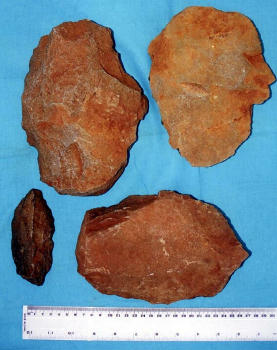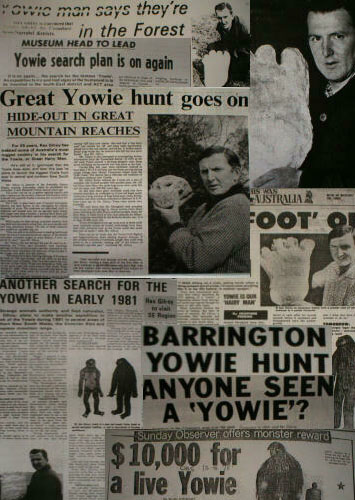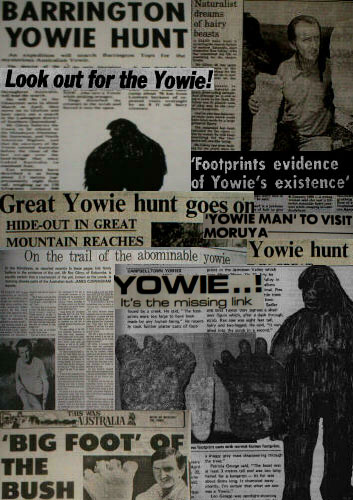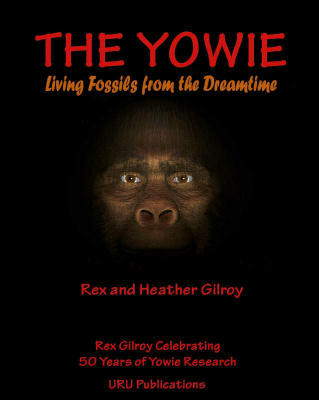Little Hairy People
This article is composed of extracts from the 2007 book:
“The Yowie Mystery - Living Fossils From The Dreamtime".Copyright (c) 2007 Rex Gilroy, Uru Publications.
Many people believe that I only attained the “Yowie Man” title in the mid-1970s after the major newspapers ‘discovered’ my researches. Actually I was given the title by radio announcers after initial interviews on the former Blue Mountains Radio Station 2KA at Katoomba.
Thus the title “Rex the Yowie Man” goes back to as early as the beginning of the 1960s. In more recent times my title has been plagiarised by a certain ‘gentleman’ who uses it to promote himself through newspaper and television ‘stunts’.
Despite his boasts to have “learnt more about the Yowie in four years than Rex Gilroy has in 45 years” [as bragged on one American radio station interview] he is in no way a scientific investigator. Indeed, he and his kind have done nothing but help bring discredit upon the very sciences of relict Hominology and Cryptozoology that they claim to be ‘experts’ or ‘world authorities’ on.
Despite the fact that these people continue to do their best to slander and discredit my lifetime’s dedicated research [which for the past 33 years has included my wife Heather], I will not name them, as this would lower me to their level! Heather and I believe we have this evidence; evidence that is far more scientific. We challenge our ‘big mouth’ opponents to put their own evidence where their mouths are or else shut up!
Left Photo: Close up view of three Nundle ‘choppers’ and the spearhead. Photo copyright © Rex Gilroy 2007.
“Little hairy people” are found in Aboriginal folklore Australia-wide and the mass of information on them is beyond the scope of this chapter, which is concerned with early European knowledge of pygmy-size natives who were often confused with the general “hairy man” traditions of the Aborigines. It is certain that there are several different types of pygmy in Aboriginal folklore Australia-wide and that these inhabited [and supposedly still do] not only mountainous forest country and coastal scrublands, but also desert regions. The names for all these little folk vary with the many Aboriginal languages, but generally stand for “little hairy men; little hairy red men or little hairy people”.
The most famous Australian pygmy folk are the Birranbindins of the far north Queensland jungles. The Aborigines ruthlessly hunted and killed the Birranbindins at every opportunity. This had the effect of driving them deeper into the mountains. The truth was, the Birranbindins were shy, timid natives who feared the Aborigines, avoiding them at every opportunity.
It was once thought by scientists that these little natives were a separate race which had preceded the Aborigines to Australia, for their Negroid-like rounded heads and crinkly black hair is deceptive. However, these features and the smallish stature are typical of natives who have lived for generations in a darkened forest environment, existing upon forest foods. The North Queensland pygmies are in fact Australoid rather than Negroid, and probably related to the former Tasmanian Aborigines whose features are identical, although these people were slightly taller.
Even so, the coastal and inland Aborigines did not regard these smaller Australoids as their own kind, linking them with the “hairy people”. They were known as the ‘Jundjdy’, or “little hairy red men”, alluding to their fine body hair, which could sometimes be a reddish colour. The origins of the Australian pygmy races are not fully known. It is certain that more than one race may have very ancient connections with Homo erectus, or perhaps some even earlier south-east Asian race. Indeed, Anthropologists generally agree that the pygmy races worldwide have a very ancient past and origins not yet entirely understood.
Perhaps Australia may yet reveal many, if not all the answers to these puzzles which perplex them. What is known of our pygmies is that there are tales of them from every Australian state, whether from the Dreamtime or in the modern era. Here we shall concentrate upon the early pioneer period accounts. Photograph right: Aboriginal Girl wearing a Kangaroo hide Garment. Photographer Unknown. I will credit anyone who owns this photograph.
Many early settlers and their children are said to have seen them, according to the late Melbourne Ward, FRZS who gathered early reports and Aboriginal traditions of these little beings, at his natural history museum which formerly stood in the grounds of the Hydro Majestic Resort at Medlow Bath. This author was a personal friend of ‘Mel’ who provided me with a considerable amount of local Aboriginal folklore, which I was forever writing down on the spot in exercise books. His death on October 6th 1966 was a great loss to Australian anthropology.
‘Mel’ was lucky to be able to speak with ageing Aborigines who still lived in the Blue Mountains in the early 1940s. From them he learnt that the Gubba had a ceremonial life like their taller Boothoo geermi neighbours, and that among other aspects, they buried their dead in the ground over which they placed little stone markers. They erected small stone arrangements for obscure ceremonial purposes, and when not inhabiting rock overhangs, constructed small bark shelters in the forests.
Perhaps children who used to tell their parents of having seen ‘little black fairies’ in the bushlands that once bordered the Georges River in the Bankstown/Lansvale/Liverpool/Casula areas were not imagining any more than some adults who also claimed to have seen them! They were part of local European tales well into the early 20th century. Sightings claims died away with the gradual destruction of the scrublands as the post World War Two land development spread out beyond Sydney.
The Gubba or Yagan are still very real to the Aborigines and also the Europeans who are adamant that they have seen them. The early settlers accounts of pygmy folk seen in the Blue Mountains and other parts of Australia make interesting reading. There were, according to Melbourne Ward, sightings of little black pygmy folk out on Narrow Neck Plateau, south-west of Katoomba Township and also in the Megalong Valley below. During 1914, 1922 and 1923 hikers reported having spotted small groups of these little natives scurrying away into the bush at their approach.
During 1955 a camper stumbled upon the skeleton of a pygmy-size native, laid out in a narrow rock shelter. Some skin still clung to the bones and some scalp with hair remained on the skull. The remains had been dressed in a wallaby hide cloak and a 5ft long spear placed alongside the body. The location was somewhere deep in the Jenolan Range, which lies near the Kanangra Boyd National Park. However, the man left the body where it lay and never revealed the location. The Gubba or Yagan were spoken of by Aborigines around Leura and some lower Blue Mountains towns back in the 1900s and 1920s when some people claimed to have seen a few of these 40 to 60cm tall pygmy folk on the edge of their scrub-bordering backyards.
Australian pygmy traditions could fill a book of their own. Yet these traditions are backed up by more than sightings reports as this book will show, demonstrating that they are no mere will o’ the wisps’, but living relics of our prehistoric past.
“The Yowie Mystery - Living Fossils From The Dreamtime".
“The Yowie Mystery - Living Fossils From The Dreamtime". Special Dedication. The Authors dedicate this book to the late Charles Melbourne Ward F.Z.S.; F.R.Z.S. known to his great many friends simply as ‘Mel’. Together with his wife Halley, he operated a natural history museum in the grounds of the Hydro Majestic Hotel at Medlow Bath for many years and also another established at Echo Point, Katoomba. It was ‘Mel’ who first taught me how to collect, record and study natural history specimens, beginning when I was aged 11 years old on holidays with my parents at Katoomba in 1954. Thereafter, every school holidays spent in Katoomba began with a visit to ‘Mel’ at his Medlow Bath Museum to inform him how my fledgling natural science studies were progressing!
As a result and after my parents moved from our Lansvale [western Sydney] home to Katoomba, the Gilroys and Wards became close friends. There was hardly a week which did not see me peddling my pushbike from our North Katoomba home up the Great Western Highway to see ‘Mel’ at his museum for more instruction. Mel Ward possessed a wide knowledge of the culture of the Australian Aborigines and that of the former local Blue Mountains tribes in particular.
He was also a firm believer in the “Hairy Man” and supported my researches in this regard. At my 21st birthday party, held at the Homesdale Function Centre, at Katoomba on Saturday night 8th November 1964, I well recall how my old friend, in front of a large gathering, congratulated me on my researches and the large natural science collection that I was forming and then said: “You’ve done a fantastic job Rex, BUT IT’S ABOUT TIME THAT YOU STARTED MAKING SOME BLOODY MONEY OUT OF IT” in a loud voice that brought the house down!
That following week, together with my father Mr W.F. [Bill] Gilroy, I began a search of local venues, which soon resulted in the acquisition of the lease from the Blue Mountains City Council of the Mt York Tea Rooms, outside Mt Victoria, the rest they as “is history”. Two years late, on October 6th 1966, Mel Ward was dead, having passed away in his sleep. He once said to my father that I was “the Mel Ward of Tomorrow” and I am certain that Mel would be pleased to know that I have indeed followed in his footsteps.
Mel led an adventurous life. The son of Hugh J. Ward, a famous Shakespearean actor of the early 20th century, Mel was encouraged to go on the stage by his father but Mel developed a passion for the natural sciences and his wealthy parents helped him become established. In his lifetime of achievement, Mel became recognised as a world authority on Crustaceans and an anthropologist. He was made a Fellow of the Royal Zoological Society of New South Wales and was pleased when I too became a member of the Society in 1963. He encouraged me, not long before his death, to take on the Presidency of the Society’s Entomological section, where I served for three years from 1966 to 1969.
That he achieved so many things in the course of his lifetime researches is remarkable, because like this author, he was an amateur with not one university degree to his name! I am certain that my old friend would be delighted at the fact that, together with heather, I am now writing and publishing book on the subjects he loved and on the Yowie in particular. He taught me never to blindly follow the textbook and dare to question dogmas and not be told what to think! I have certainly followed his advice. Knowing Mel Ward as I did I know he would wholeheartedly approve of the scientific approach of this book, therefore “Mel”
This Book is for You!
Rex Gilroy - Australian Yowie Research Centre, Katoomba, NSW.
Monday 25th June 2007I also present sensible advice to any future would-be Yowie investigators. The reader will also be awed at the great many discoveries my wife Heather and I have made in all our years together in the field. I feel privileged to be the founder of Yowie research and to have encouraged other, sensible researchers to follow my example. The search for surviving relict hominids in remote, hidden regions of the world, has been called the “last great search”, and it is both a fascinating and exciting one. Rex Gilroy may be contacted at the Australalian Yowie Research Centre, PO Box 202, Katoomba. NSW 2780. Ph 02 4782 3441 or email New Email Address as of June 2009 randhgilroy44@bigpond.com on or visit our website : http://www.mysteriousaustralia.com/ or http://www.australianyowieresearchcentre.com/ or http://www.rexgilroy.com/
Newspaper Articles on Rex Gilroy's Lifetime Search for the Australian Yowie
Newspaper Articles on Rex Gilroy's Lifetime Search for the Australian Yowie
Aboriginal/Koori Names for the Australian Yowie
To present the Yowie mystery in its proper context, relict hominid evidence from south-east Asia, New Guinea, other west Pacific Islands and New Zealand is revealed, demonstrating how the ancestors of these ‘manimals’ once spread out across the earth via land-bridges that formerly joined Australia/New Guinea/New Zealand with what is now island south-east Asia to the Asian mainland.
“Hairy man” was a name given by the Aborigines to any non-Aboriginal race with which they shared this continent, but the term centred primarily upon at least three basic forms. These forms were either the height of an average human being, an enormous man-like and also ape-like form. All were known by different names Australia-wide, but all meant either “hairy man” or “great hairy man”.






